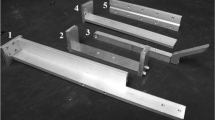Abstract
This paper presents a new approach to part classification in group technology. It advocates the introduction of a feature-based solid-modelling scheme for part representation which, in turn, helps in identifying features of interest. The extracted features of the part are then used to determine the part family to which the part belongs. A parallel distributed processing (PDP) model has been utilised in developing a learning module for the part-classification problem. The proposed model has been implemented in the Unix environment of a Sun work-station. The usefulness of the proposed model has been validated with an example of 16 parts in three part families.
Similar content being viewed by others
References
N. L. Hyer and U. Wemmerlov, “Group technology and productivity”,Harvard Business Review,62(4), pp. 140–149, July–August 1984.
U. Wemmerlov and N. L. Hyer, “Cellular manufacturing in the US industry: a survey of users”,International Journal of Production Research, 27(9), pp. 1511–1530, 1989.
C. Han and I. Ham, “Multiobjective cluster analysis for part family formations”,Journal of Manufacturing Systems,5(4), pp. 223–230, 1987.
A. Vannelli and K. R. Kumar, “A method for finding minimal bottle-neck cells for grouping part-machine families”International Journal of Production Research,24(2), pp. 387–400, 1986.
H. L. Wu, R. Venugopal and M. M. Barash, “Design of a cellular manufacturing system: a syntactic pattern recognition approach”,Journal of Manufacturing Systems,5(2), pp. 81–87, 1987.
J. R. King, “Machine-component grouping in production flow analysis: an approach using a rank order clustering algorithm”International Journal of Production Research,18(2), pp. 213–232, 1980.
Y. B. Moon, “An interactive activation and competition model for machine-part family formation in group technology”,Proceedings of the International Joint Conference on Neural Networks, Washington DC, vol 2, pp. 667–670, 15–19 January 1990.
J. L. Batra and R. Rajagopalan, “Composite component through graphs and fuzzy clusters”,Proceedings of the 18th International Machine Tool Design and Research Conference, UK, pp. 801–807, 1977.
J. Peklenik and J. Grum, “Investigation of the computer aided classification of parts”,Annals of the CIRP,29(1), pp. 319–323, 1980.
J. J. Shah and A. S. Bhatnagar, “Group technology classification from feature-based geometric models”,Manufacturing Review, 2(3), pp. 204–213, 1989.
H. A. ElMaraghy and P. Gu, “Feature based expert parts assignment in cellular manufacturing”,Journal of Manufacturing Systems,8(2), pp., 139–152, 1989.
H. Xu and H. Wang, “Part family formation for GT applications based on fuzzy mathematics”,International Journal of Production Research,27(9), pp. 1637–1651, 1989.
U. Roy and C. R. Liu, “Feature based representational scheme of a solid modeller for providing dimensioning and tolerancing information”,Robotics and Computer-Integrated Manufacturing, an International Journal,4(3/4), pp. 335–345, 1988.
U. Roy, M. D. Pollard, K. Mantooth and C. R. Liu, “Tolerance representation scheme in solid model: Part I”,Proceedings of 1989 Design Automation Conference, Montreal, Canada, pp. 1–10, 1989.
U. Roy, M. D. Pollard, K. Mantooth and C. R. Liu, “Tolerance representation scheme in solid model: Part II”,Proceedings of 1989 Design Automation Conference, Montreal, Canada, pp. 11–17, 1989.
CAM-I's Illustrated Glossary of Workpiece Form Features, CAM-I, R-80-PPP-02.1, 1981.
D. E. Rumelhart, G. E. Hinton and J. L. McClelland, “A general network for parallel distributed processing”, in D. E. Rumelhart and J. L. McClelland (eds),Parallel Distributed Processing: Explorations in the Microstructure of Cognition, MIT Press, Cambridge MA, vol. 1, pp. 45–76, 1986.
D. E. Rumelhart, G. E. Hinton and R. J. Williams, “Learning internal representations by error propagation”, in D. E. Rumelhart and J. L. McClelland (eds),Parallel Distributed Processing: Explorations in the Microstructure of Cognition, MIT Press, Cambridge, MA, vol. 1, pp. 318–362 1986.
J. L. McClelland and D. E. Rumelhart,Exploration in Parallel Distributed Processing: A Handbook of Models, Programs, and Exercises, MIT Press, Cambridge MA, 1988.
Author information
Authors and Affiliations
Rights and permissions
About this article
Cite this article
Moon, Y.B., Roy, U. Learning group-technology part families from solid models by parallel distributed processing. Int J Adv Manuf Technol 7, 109–118 (1992). https://doi.org/10.1007/BF02601577
Accepted:
Issue Date:
DOI: https://doi.org/10.1007/BF02601577




